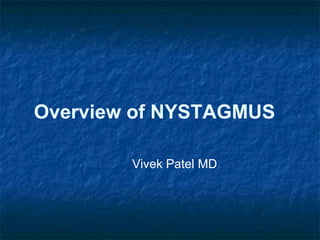
Ahd neuro-opthalmology - v. patel - nystagmus (1)
- 1. Overview of NYSTAGMUS Vivek Patel MD
- 2. OBJECTIVES Definition, description Neuroanatomical basis Instrinsic localizing value Representative cases
- 3. DEFINITION Disorder of ocular motor instability resulting in spontaneous, involuntary, rhythmic oscillations of the eyes Congenital vs. acquired “jerk” nystagmus vs. pendular “true” nystagmus vs. nystagmoid movements
- 4. Conjugate vs. disconjugate vs. dissociated Trajectory may be horizontal, vertical, torsional, or mixed Description of amplitude, frequency, velocity, and intensity may vary with changes in gaze position May be influenced by the integrity of the afferent visual system May exhibit a “null” point
- 5. 3 main mechanism of maintaining steady gaze: 1) fixation: a) prevent retinal image drift b) suppress unwanted saccades 2) VOR 3) eccentric gaze holding
- 6. Pulse (phasic) and step (tonic) outputs must be balanced for appropriate gaze-holding. Significant cerebellar (vermis) calibration Horizontal: phasic = PPRF tonic = NPH, MVN = neural integrators Vertical: phasic = riMLF tonic = iNC = neural integrator
- 7. NEUROANATOMICAL BASIS Leigh & Zee, Neurology of Eye Movements, 3rd ed., 1998Leigh & Zee, Neurology of Eye Movements, 3rd ed., 1998
- 8. Not always a sign of disease… Physiological: Usually conjugate Preserves clear vision during self-rotation unsustained end-point nystagmus Vestibular nystagmus (brief sustained rot.) OKN (visually driven….uses pursuit mech.)
- 9. CHILDHOOD NYSTAGMUS Congenital nystagmus: usually recognized in first few months of life – life long May have good vision or poor vision Most often occurs in isolation (motor), but may be associated with albinism, LCA, achromatopsia, or optic atrophy Uniplanar, horizontal trajectory irrespective of gaze position No oscillopsia Reversal of OKN direction Exponential increase in slow phase velocity Conjugate Null point (may have resultant head turn) Amplified by attempted fixation (distant) Dampened by convergence and darkness Absent in sleep Association with esotropia
- 10. Latent nystagmus: Usually appears within first few months of life Horizontal jerk nystagmus appearing only under monocular viewing conditions Fast phase beats away from occluded eye Strong association with esotropia Usually poor stereopsis May explain subnormal visual acuity tested monocularly Manifest latent nystagmus: Present even when both eyes are open Loss of peripheral fusion
- 11. Monocular nystagmus of childhood: Usually monocular, vertical, low amplitude oscillation Eye with nystagmus may have afferent visual dysfunction Requires neuroimaging (chiasmal glioma) Spasmus Nutans: Asymmetric or monocular low-amplitude oscillations May be horizontal, vertical or torsional Head nodding Torticollis or abnormal head posture Begins in infancy, usually resolved by age 3 to 5 Requires neuroimaging
- 13. PERIPHERAL VS. CENTRAL VESTIBULAR NYSTAGMUS PERIPHERAL Severe vertigo Days to weeks duration Hearing loss, tinnitus associated Usually horizontal with torsion Very rarely purely vertical or torsional Dampened with visual fixation Commonly peripheral vestibular organ dysfunction: labyrynthitis, meniere’s CENTRAL • None or mild vertigo • Often chronic • May be purely vertical or torsional • visual fixation usually has no effect • Etiologies commonly vascular, demyelination, pharmacologic, toxic • Downbeat, upbeat, torsional
- 14. Gaze evoked nystagmus: One of the most common forms of central nystagmus Inability to maintain eccentric gaze “leaky integrator” -- miscalibration between pulse and step inputs Symmetric cerebellar flocculus implicated Age, anti-convulsant therapy, alcoholic degeneration, stroke, demyelination Baclofen effective
- 15. Downbeat nystagmus: Defect in vertical gaze holding Asymmetric inputs from vertical semi-circular canals produce upward slow drift of eyes Defect in fastigial nuclei calibration Secondary downward corrective fast phase Obeys Alexander’s law Localizes to cervico-medullary junction Arnold-Chiari malformation Treatment with baclofen, clonazepam, base-out prisms
- 16. Upbeat nystagmus: Present in primary position or upgaze Classically localizes to a lesion of anterior cerebellar vermis More generally implicates posterior fossa disease Etiologies include stroke, cerebellar degeneration, demyelination, toxic exposures Periodic alternating nystagmus: Horizontal oscillation characterized by a periodic reversal in the direction of nystagmus due a shift in the null point Duration of cycles from 30 seconds to 6 minutes Classically a lesion of the cerebellar nodulus MS, drugs, ethanol, paraneoplastic syndromes Baclofen effective
- 17. •Bruns nystagmus: • associated with CPA tumors • high frequency, low amplitude nystagmus (fast-phase away from lesion) • low frequency, large amplitude nystagmus on ipsilateral gaze (fast phase toward lesion) • shift from eye movement response to vestibular imbalance to that of defective gaze holding
- 18. See-saw nystagmus: Disconjugate vertical nystagmus (pendular vs. jerk) Upward moving eye intorts while downard eye extorts Localizes to lesions of diencephalon Visual fields may be useful (disruption of afferents to cerebellum) Ocular flutter/opsoclonus: Burst-like, incoordinated saccadic excursions with high frequency, low amplitude No intersaccadic latency Purely horizontal: ocular flutter Multiplanar: opsoclonus Reflect pause cell dysfunction (pons) Must consider paraneoplastic etiology: SCC of lung, ovarian, breast CA Neuroblastoma in children
- 20. Acquired pendular nystagmus: Can be vertical, horizontal, torsional, or any combination (usually one predominates) Usually disconjugate or dissociated Oscillopsia ++ MS, whipple’s, oculopalatal myoclonus Combination of afferent dysfunction and cerebellar calibration
- 21. Oculopalatal myoclonus: Vertical pendular eye movements associated with rhythmic upward movement of palate Caudal brainstem pathology: red nucleus, inferior olive, and dentate nuc. Convergence-retraction nystagmus: Commonly associated with dorsal midbrain syndrome May be associated with other Parinaud’s findings Not a true nystagmus: co-contraction of horizontal recti on attempted upgaze Localizes to pretectal area, posterior commissure, INC Pineal cyst or tumor, demyelination, stroke
- 22. SUMMARY Recognize physiologic vs. pathological Appropriate characterization important Presence of nystagmus may correlate with significant afferent visual dysfunction Recognition of nystagmus may facilitate subsequent neurological or medical investigations (know where to look) Treatment options do exist